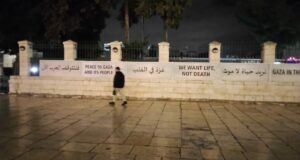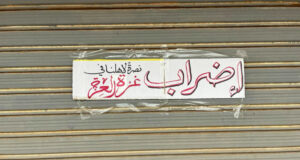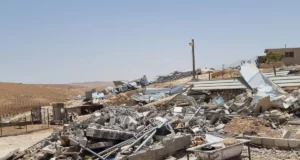by Palestine Solidarity Project
On September 15, 2006, Palestinian and international activists removed large sections of a razor wire barrier erected on Palestinian land in the Al-Khalil (Hebron) region, and designed to isolate and bisect a village.
The fence was repeatedly cut, metal stakes removed, and the razor wire ripped to be rendered unusable. The activists worked in teams, sabotaging the fence in many strategic areas. By the end of the action, the activists had destroyed large tracts of the barrier, and created more than six entry and exit points in the fence. Each entry/exit point created spanned more than seven meters. Having accomplished their goal of opening the crossings, the activists returned safely without being observed by Occupation forces.
On September 17, 2006, for the third time in approximately two weeks, Palestinian and international activists carried out a successful direct action to remove illegal fence and razor wire barriers in the Al-Khalil region. The activists were able to open at least six entry and exit points in the razor wire barrier. The section of the barrier that was targeted was very near to an Occupation checkpoint, and the activists were able to complete their work prior to spotting soldiers en route on foot.
These particular barriers, both located in the Al-Khalil region, were chosen because of frequent requests made to PSP by members of the communities affected. The existence of these illegal structures restricts the movement of the Palestinian people and redraws the West Bank borders in the name of Israeli ‘security.’ The military claims that the barrier is necessary to prevent attackers from crossing into Israel. This fence is the preliminary installation of what will soon become part of the Apartheid Wall.
The route of the barrier has annexed some families by placing them on the ‘Israeli’ side of the barrier, isolating their homes from their villages. Many farmers in the villages have similarly had their land annexed; the barrier makes their land inaccessible. Now, with the fences disabled, the Palestinians are able to reach their homes, and farm land more easily. By destroying the fence in several locations, PSP was able to create access points for farmers and other travelers to enter and exit the area. This action was also designed to slow the progress of the Apartheid Wall by delaying the process and making it slower.
This is the third direct action undertaken by PSP in two weeks. PSP is a newly developed, Palestinian-led, non-violent movement to resist the Israeli occupation.
For more information on the Palestine Solidarity Project, please contact palestine_project@yahoo.com or visit the website at:
palestinesolidarityproject.wordpress.com
Updated 26th September.
 International Solidarity Movement Nonviolence. Justice. Freedom.
International Solidarity Movement Nonviolence. Justice. Freedom.


